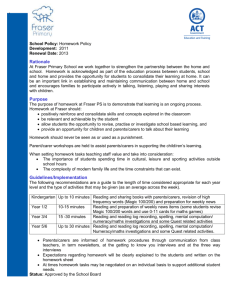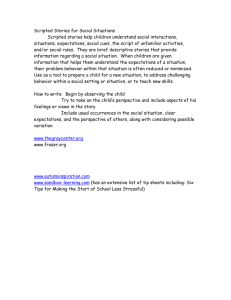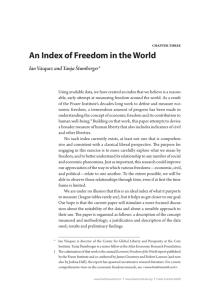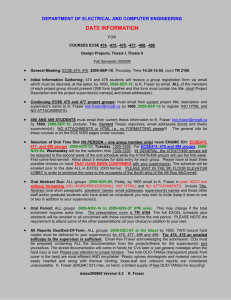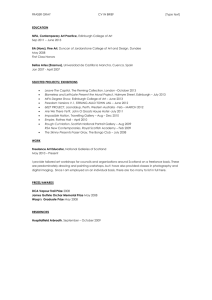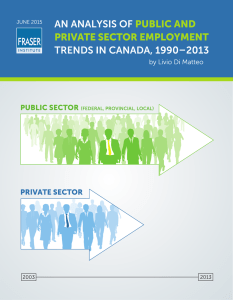A Compact Statement of a Cost-based Theory of
advertisement
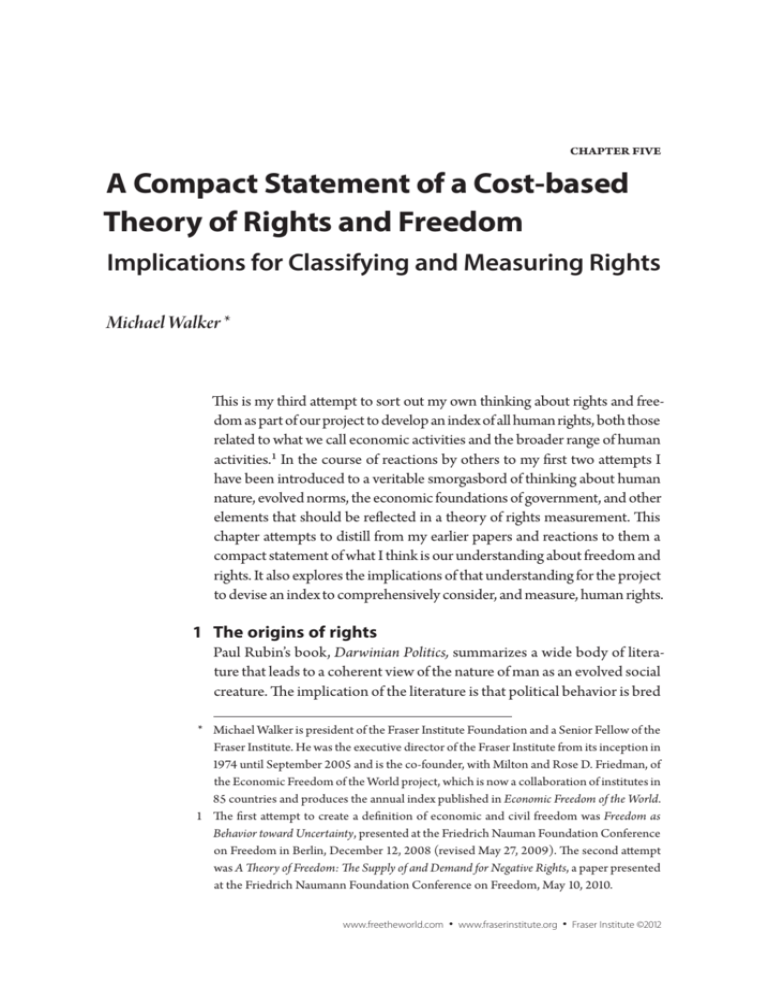
chapter five A Compact Statement of a Cost-based Theory of Rights and Freedom Implications for Classifying and Measuring Rights Michael Walker * This is my third attempt to sort out my own thinking about rights and freedom as part of our project to develop an index of all human rights, both those related to what we call economic activities and the broader range of human activities.1 In the course of reactions by others to my first two attempts I have been introduced to a veritable smorgasbord of thinking about human nature, evolved norms, the economic foundations of government, and other elements that should be reflected in a theory of rights measurement. This chapter attempts to distill from my earlier papers and reactions to them a compact statement of what I think is our understanding about freedom and rights. It also explores the implications of that understanding for the project to devise an index to comprehensively consider, and measure, human rights. 1 The origins of rights Paul Rubin’s book, Darwinian Politics, summarizes a wide body of literature that leads to a coherent view of the nature of man as an evolved social creature. The implication of the literature is that political behavior is bred * Michael Walker is president of the Fraser Institute Foundation and a Senior Fellow of the Fraser Institute. He was the executive director of the Fraser Institute from its inception in 1974 until September 2005 and is the co-founder, with Milton and Rose D. Friedman, of the Economic Freedom of the World project, which is now a collaboration of institutes in 85 countries and produces the annual index published in Economic Freedom of the World. 1 The first attempt to create a definition of economic and civil freedom was Freedom as Behavior toward Uncertainty, presented at the Friedrich Nauman Foundation Conference on Freedom in Berlin, December 12, 2008 (revised May 27, 2009). The second attempt was A Theory of Freedom: The Supply of and Demand for Negative Rights, a paper presented at the Friedrich Naumann Foundation Conference on Freedom, May 10, 2010. www.freetheworld.com • www.fraserinstitute.org • Fraser Institute ©2012 138 • Towards a Worldwide Index of Human Freedom in the bone and is a result of fitness-sorting amongst competing hominids in the Pleistocene period of human development. During that phase of evolution, the tribal/community groups were composed of between 50 to 100 individuals; according to Rubin’s synopsis, the attitudes, coping mechanisms, and sense of entitlement that modern humans manifest reflect that social structure. The principal implication of Rubin’s theory about how we got to be the way we are is that “human nature” has evolved, and so the departure point of any analysis of rights must be that there is a hard-wired set of preferences that will be expressed in the political structures that emerge. (This is distinct from the notion that every generation is born as barbarians, or as blank slates, which have to be instructed and formed in a particular way to be compatible with effective social living.) As Rubin points out, it is clear that social norms and political conduct emerged in apes before the split that produced chimpanzees and humanoids as separate species because we observe complex political behavior in chimps.2 The taste for rights and the sense of justice are part of evolved human nature. The “shoulds” that play a key role in shaping human action are genetically imparted. A child is not born as a blank slate, but rather as an individual with pre-conceived notions of what “should be,” and therefore compatible with only a limited range of actual social structures.3 As economists, we take tastes as given. The implication of Rubin’s book is that the framework of tastes about rights are “given” in a genetic sense and not just presumed to be given as an analytical convenience in presenting complex behavior in three-dimensional spatial models. Freedom and the exchange model of rights In the second of my two papers, I started with the premise developed by Fred McMahon and Tom Palmer that freedom was a bundle of rights 2 In his 2002 book, The Blank Slate, Steven Pinker explores extensively the notion of human nature from the point of view of evolutionary psychology and convincingly synopsizes a vast body of research pointing to the existence of a genetically based human nature. 3 It follows as a corollary of this model that it is possible that evolved tastes might differ somewhat over time as groups are exposed to different environmental challenges. The “shoulds” that prove to have superior fitness in northern climates might well be different from those amenable to moderate climes. While neither Rubin nor the authors he cites seem to suggest this, it difficult to understand why it would not be true. A particular feature of the pre-hominids who preceded both chimps and humans in the evolutionary chain was that they lived in benign climates, as far as we know. No pre-hominid fossils have yet been discovered outside the tropical zones of climatic variation and chimps, the principal co-existing ape to display complex political behavior, live only in tropical zones. The successful migration of the pre-hominids out of Africa to the rest of the world would suggest that perhaps some modification of social norms would have been necessary in the process. Fraser Institute ©2012 • www.fraserinstitute.org • www.freetheworld.com A Compact Statement of a Cost-based Theory of Rights and Freedom • 139 and attempted to work out the implications of that concept for our indexbuilding enterprise. I suggested that we consider rights as part of the basket of things that consumers seek to acquire to maximize their utility, subject to the constraint of the total resources available to them. A key factor leading to this approach is the notion that while the aspiration or inbred preference for certain rights is given, the acquisition of these rights requires the expenditure of resources. As distinct from the aspiration to have certain rights, the acquisition of rights is not costless. I therefore proposed that we had to conceive of a rights market in which the demand for rights emerged from a joint maximization process. In this process, rights and other desirable commodities are traded off, reflecting preferences for rights and other things. In turn, the quantity of the different kinds of rights demanded would reflect the total resources available and the “price” of rights. I did not realize it at the time, but the model I was suggesting was similar in approach to one proposed by Randy Holcombe in his wonderful book, The Economic Foundations of Government. There, Holcombe proposes what he calls an “exchange model of rights” in which individuals will have the rights that they can bargain for either individually or collectively (1994: 11-71). As he notes, “There are no implications in this analysis regarding what rights individuals should have. The model considers only what rights individuals would be expected to be able to exercise as result of the bargaining process under various conditions. One might want to draw some normative implications for the type of rights societies should have, but to do so first requires an understanding of the underlying process of social interaction” (Holcombe, 1994: 71). Holcombe comes to his understanding by considering the model of government and its constraints. I come to my understanding by regarding rights as just another of the features of the good life that individuals would like to have and which they will have to use a portion of their resources to acquire. The rights we observe are the product of this trade-off process of preferences subject to the constraint of limited resources. Acknowledgment and the supply of rights The granting process and the production process comprise the supply of rights. The granting process is essentially the political activity that decides who will have what rights, or, to state it more precisely, who can legitimately lay claim to what rights. The articulation of the rightsgranting process consumes much of the Holcombe exchange model of rights and is something that, for our purposes, we are going to assume has already occurred. The only thing to note is that the granting of rights process itself is resource intensive and is, like the production of rights, an expensive activity. www.freetheworld.com • www.fraserinstitute.org • Fraser Institute ©2012 140 • Towards a Worldwide Index of Human Freedom A curious feature of rights is that while citizens may aspire to have them, and may expend the resources to acquire them, whether they are successful or not depends on the opinions and actions of their fellow citizens. The demand for rights is individual, but the supply is by its nature collective, since the only rights that any citizen can acquire are determined ultimately by the legal and political system in the jurisdiction in which they live. For example, in common-law jurisdictions, the law—and hence the rights system—is composed of three components: constitution laws, the statutes of government, and the decisions of the court system— especially the highest level of appeal court. The development of the supply of rights reflects a variety of actions in each of these spheres. Many of the foundational or constitutional aspects of the Common Law countries emerged as a result of the direct effort of citizens to limit the sovereignty of the king. The Magna Carta in its various manifestations is one such example and emphasizes the role that private action to assert rights, with all of its attendant costs, has played in the evolution of rights. The power of such agreements to establish rights has depended on their endorsement and acceptance by Parliaments and Congresses and their being upheld in the decisions of court systems. Each of these reinforcements of the initial rights required both private and public costs to achieve and relied upon the integrity of the system of laws, specifically, the systematic application of known rules in the determination of outcomes. One example of the systematic application of rules is that used by a Congress or Parliament in coming to a decision about whether to support or not to support a particular right—and to what extent. The ubiquitous aspect of the rights granting process in all the jurisdictions where rights are found is that it is a collective activity. While individuals have an inbred taste for rights, the acquisition of these rights depends in part on the acknowledgement by fellow citizens that the individual is, in fact, entitled to them. While it is possible that this acknowledgement could occur under conditions of dictatorship, casual empiricism suggests that in general, rights acknowledgement occurs in jurisdictions having free political institutions. The exceptions, like Singapore and Hong Kong, are colonial states to which the rights apparatus was imported by the colonial rulers from their already developed systems at home. The production of the supply of rights The production function articulates the way in which resources, knowhow, and effort are combined to produce goods, services, and, it is suggested here, rights. And there must be a production function. Even in jurisdictions where rights are acknowledged by some process, they still have to be produced—they don’t just exist. Consider, for example, the Fraser Institute ©2012 • www.fraserinstitute.org • www.freetheworld.com A Compact Statement of a Cost-based Theory of Rights and Freedom • 141 right to personal security and the right to own property. Producing and providing both of those rights has clear resource costs. Furthermore, there are both individual and community costs associated with producing rights, with the relative burden varying with the sort of right considered. Personal security Every person wants the right to security of the person, that is, freedom from violence rendered by someone else. While the preference for this security is costless, the acquisition of the right is not. The right to security as distinct from the preference for it requires the actual provision of security and entails policing, a judiciary, and some method for incarcerating or punishing those who violate the right. While in principle all of these functions could be provided privately subject to subscription, in practice they are almost exclusively provided in a collective process involving control by elected officials. In any event, it does not matter whether this right is effected by government or private providers; it is going to be costly to realize the right to security. 4 Property rights In 19th century United States, farmers could, in principle, own very large tracts of land in the mid-western and western states. However, when cattle and other animals foraged for food, it reduced the land’s value to the extent that it was only possible to use land that had on it a sufficient number of 4 The history of the provision of security is interesting when we propose to con- struct an index comparing the rights to which citizens of different countries are entitled. The most important element in providing security is to deter people from engaging in violence. Historically, the way society did that was to maintain and enforce penalties sufficiently onerous to overwhelm the cost/benefit calculus of most would-be offenders. The more onerous the penalty compared to any benefit associated with the crime, the lower the incidence of the crime. In Canada during the 19th century, there were 123 crimes for which death was the punishment. They included theft, burglary, rape, homosexuality, bestiality, treason, and, for members of the military, cowardice and desertion. Typically the executions were by hanging and until after the 1870s the body was left hanging in a public place—sometimes covered in tar to protect it from the weather! When viewed from the perspective of a modern, advanced, Western democracy, the penalties are horrific to contemplate, but they made the maintenance of security much cheaper than it would otherwise have been. In the pursuit of swift and brutal justice, the investigation and prosecution of the criminal often involved what would today be regarded as a miscarriage of justice. The gradual improvement in the administration of justice and the emergence of the notion of perpetrators’ rights and the graduation of penalties to reflect the greater probability of apprehension had to await the availability of resources to support such an elaboration of the security apparatus. In many parts of the world today, neither the resources nor that elaboration have yet arrived. www.freetheworld.com • www.fraserinstitute.org • Fraser Institute ©2012 142 • Towards a Worldwide Index of Human Freedom trees to supply the required fencing to protect the crops. The invention of barbed wire in 1868 reduced the cost of fencing, and therefore made feasible the exertion of property rights where none could exist before. (For a history of this development and its implications see, Richard Hornbeck’s “Barbed Wire, Property Rights and Agricultural Development .”) These examples illustrate the two different kinds of costs—private and public—involved in the production of rights. The right to security involves both the cost of self-protection (private) and the costs of maintaining the policing and justice system (public). The farmer’s rights to his property could not be exerted until the cost of doing so fell to a level corresponding to the value of the rights that would be secured. In most jurisdictions, in addition to the farmer’s private cost, there is the added cost of the courts, the land registry, and the police to enforce the property right that has been agreed is owned by the farmer. In a modern context, that sort of calculus of the costs and benefits of rights is still very much a factor as business owners and householders decide whether it is worth their while to exert their rights. For example, a recording artist may find out that people have been stealing her tracks. They have, in effect, been violating her property rights. Whether she pursues the theft in court will depend on the cost of doing so compared to the money lost to the thief. While it is tempting to say that her rights exist and are being violated by the thieves, there is, in fact, a doctrine of property law in the Common Law that requires people to exert their rights or else lose them! That used to be the case with common trespass. Landowners who failed to make an adequate effort to prevent trespassers from using their land sometimes found that people traversing their land were awarded the right to continue to do so by the courts. (Statute law in many jurisdictions has now superseded this earned right of trespass.) Even in mature pluralistic societies that have a full compliment of rights, the maintenance of the right to security continues to require private and public costs, as is reflected in the resources spent on policing, the courts, and the prison system, as well as the increasing amounts spent on private security firms, alarm systems, and their monitoring. (Private police forces, which in Canada, for example, outnumber public police by a wide margin, are engaged to protect the property of businesses and households by whom the public police force is found to be inadequate. In such instances, the demand for security rights is more readily observed as a service like any other and it seems less awkward to apply the standard economic model to its provenance.) The evolution of the stock of rights It is convenient when thinking about personal rights to imagine them as a stockpile. The aspirations of a country’s citizens set the target for the Fraser Institute ©2012 • www.fraserinstitute.org • www.freetheworld.com A Compact Statement of a Cost-based Theory of Rights and Freedom • 143 pile’s composition. The pile is added to as citizens acquire more rights by expending the resources to get them, and is diminished as rights are lost by a failure to defend them, or because they are eclipsed by the actions of government. The stockpile analogy is useful as we attempt to measure the comparative system of rights development in different countries with differing histories, different capacities for investing in the rights development process, and potentially different targets for their ultimate pile of rights. The stockpile analogy is directly applicable in a consideration of the rights available to citizens in common law countries where precedent and case law build a stock of rights that are then available to all citizens of countries that rely on the common law. For example, Canada and the United States inherited a stock of ready-made law and court-decided rights that had been developed over the years in Britain, and now all three countries benefit from each other’s discovery of legal principles which serve to extend and enrich the stockpile of rights available in all countries in the common law tradition. The fact that the common law process of building precedents enables countries to learn from other countries means that the costs of establishing and protecting rights are thereby reduced. As noted by Tom Bingham in his masterful synoptic book, The Rule of Law, an American author writing in 1991 found that more than 900 federal and state courts in the United States had cited the Magna Carta, and in the period between 1940 and 1990, the Supreme Court had done so in more than 60 cases (Bingham, 2011: 13). There is an interesting aspect to countries governed by the Common Law: when a wealthy person or a business decides to expend the resources to fight the rights-infringing actions of a government or another citizen or corporation, the results of the fight are potentially made available to every citizen of that and every other common law country by way of the precedent established. Thus, while the fact that resources are required to exert rights and cause them to exist means that the wealthy are likely in the first instance to acquire more rights than those without resources, the common law tradition ensures that they are then made immediately available to all at a much lower cost because of the tradition of precedent. It is less clear that this process works as well in Roman or Continental legal systems, but this is more in the nature of a question than an assertion.5 5 It may be that it is this feature of the common law compared to Roman law that explains some of the differential success of the colonies of continental European countries and the colonies of Britain. The existence of this differential, and an attempt to explain it in institutional terms, were the subject of a paper by Douglass North in the first symposium of the series that lead to the creation of the Economic Freedom of the World Index (North, 1987). www.freetheworld.com • www.fraserinstitute.org • Fraser Institute ©2012 144 • Towards a Worldwide Index of Human Freedom 2 A taxonomy of rights The use of the standard economic allocation model to analyze the development of rights suggests a taxonomy of rights, which ought to guide thinking about the development of rights, that is, a taxonomy based on the resource cost of establishing various kinds of rights. As a first approximation, we can simply group rights into two categories: rights that require modest or no expenditure of resources to achieve and rights that require a significant expenditure of resources to achieve. As a way of making this taxonomic exercise crisper, we can further observe that enforcement of rights involves constraining two different kinds of actions by other actors that would affect the rights of citizens. The first sorts of actions are those taken by government against citizens. The second are actions taken by citizens against their fellow citizens. Low-cost rights—constraining government actions that impair citizens’ rights Low-cost rights are those that are entirely of the negative rights kind. They involve the actions of government and essentially require government to desist from interfering in the activities of citizens. These rights essentially cost the government nothing to establish or preserve. They are rights that often are regarded as having existed in a state of nature. The following is a list of some negative rights. 1. Don’t interfere with families and their organization. 2. Don’t interfere with economic activities of citizens as long as they are voluntarily undertaken 3. Don’t subsidize (that is, interfere by means of financial interventions) in any activities of families or business. 4. Don’t discriminate amongst citizens in the undertakings of government by race, gender, ethnicity, or in any other way. 5. Don’t prohibit voluntary activities that don’t affect uninvolved citizens. 6. Don’t prohibit any religion, club, newspaper, internet site, or other mode of communication. 7. Don’t steal from citizens by debasing the currency by clipping, sweating, or expanding the supply of fiat currency. These sorts of rights are of the kind that every government, everywhere in the world, and at every point in history, could ensure to its citizens. There is no reason for citizens of any nation not to have these rights. Their provision does not require the use of resources; they only require that government not intervene in the affairs of its citizens. Fraser Institute ©2012 • www.fraserinstitute.org • www.freetheworld.com A Compact Statement of a Cost-based Theory of Rights and Freedom • 145 High-cost rights—constraining people’s actions when they interfere with the rights of others The other kind of rights relate to actions by citizens that interfere with the rights of other citizens. These rights are referred to here as quasi-negative rights for the reason that they are not self-enforcing. In order for these rights to exist, there has to be an enforcement process that stops one citizen from interfering with the actions of another. That enforcement mechanism requires resources. Thomas Jefferson wrote in the Declaration of Independence of the American Colonies, “and to ensure these rights we have created a government.” Governments are the enforcement mechanism which ensures that the non-interference rights that the citizens acknowledge are actually enforced. Of course there is a subsidiary issue that arises once the citizens create a government and instruct it to ensure the realization of the rights which the citizens have acknowledged, and that is, how will the government be prevented from itself abusing these rights. In many of the world’s jurisdictions that lack rights, government interferences are the core reason for that lack. Personal security The primary right of the quasi-negative kind that government must enforce is the right to personal security. Citizens have the right to be free from assault by other citizens and by citizens of other countries. It is possible that in some circumstances, this right can be acquired by citizens simply desisting from interfering with others, so that in principle, this could be a truly negative right. Such societies may employ religious beliefs or other forms of taboo to ensure that members conform to a code of conduct that eliminates much, if not all, of the threats to personal security. However, in normal circumstances, reliance on mutual non-interference is not a reliable source of the right to personal security. Indeed, citizens rightly regard the preservation of their right to be not interfered with as one of the most important functions of government. This expectation implies the provision of policing. It also implies the provision of a mechanism for dealing with those who interfere with others, including a process for setting penalties to inhibit such behavior, an adjudication process, a system of prisons, etc. Property security In his book, The Mystery of Capital, Hernando de Soto notes that the most important features of property are its measurement and the acknowledgement of who owns it. In that sense, property is essentially bookkeeping and the transfer of ownership is the transfer of journal entries. But the system that keeps track of property, whether privately or publicly provided, www.freetheworld.com • www.fraserinstitute.org • Fraser Institute ©2012 146 • Towards a Worldwide Index of Human Freedom is expensive. The mechanisms to protect property from theft, even if privately provided, rely on an enforcement mechanism. The most primitive form of private property security relies on the establishment of an adequate level of deterrence to theft and encroachment. The most sophisticated relies on intricate systems of contract that define the exact nature of rights, and the portion of them that are being extended or protected by certain actions, as in the articulation of intellectual property rights. Freedom of speech While in principle the right to speak publicly about any subject is a costless right, the defense of the right may be very costly, especially when the things that are to be spoken about are contentious. There are almost daily instances of speakers on one topic or another in this or that location being denied their right to speak—even in jurisdictions in which freedom of speech would normally be assumed to exist. Recently, the attempt by former US Vice-President Richard Cheney to speak in Vancouver, Canada, was interfered with by hooligans under the guise of a “peaceful demonstration.” The demonstrators attempted to prevent people from getting into the venue where Cheney was speaking, choked one person, and jostled, pushed, and intimidated others. Benjamin Netanyahu, trying to speak to a Concordia University audience in January 2003, was turned away because of the fear of violence at the demonstrations launched to prevent him from speaking on campus. His oppressors were Islamists of various affections who did not want the Israeli prime minster to have the opportunity to speak. The University, once a place where differences of opinion were encouraged and the right to express them fervently defended, caved in to the threat of violence and cancelled the speaking event. The distinction between theoretical and actual rights: Implications for measurement The failure of the government to intervene in these free speech cases resulted in impairment of the right to free speech—and in one case, the successful use of violence to silence people who should have been permitted to speak. In both cases, the presumption of a right of the protestors to demonstrate and express their views was permitted, by creating an atmosphere of intimidation or physical violence, to trump the right of the other two: the audiences and their speakers. In Canada in 2011, the ideal of the right to free speech is protected by our constitution, and yet the right to actually speak is not always protected. In Canada, the reason there was in these and in many other cases a distinction between the actual and the theoretical right to free speech is not because of the costliness of providing the right due to a lack of Fraser Institute ©2012 • www.fraserinstitute.org • www.freetheworld.com A Compact Statement of a Cost-based Theory of Rights and Freedom • 147 resources. Rather, it reflects the fact that the well funded apparatus of the state is not acting to protect the rights which the constitution says it guarantees. It is a clear illustration of the fact that just because there is an undisputed, acknowledged right to free speech does not mean that the right actually exists in every instance, even in what is generally regarded as a free country. As with the right to the security of the person and the right to own property, the actualization of the right to free speech depends on the active expenditure of resources by the state, and the effective channeling of the resources to ensure that the rights are upheld. In those instances where the state has the resources to do so but neglects to intervene to protect the rights of citizens, or actively contrives to prevent free speech (as in the celebrated case of Ezra Levant and his publication of the Danish cartoons in the Western Standard magazine6), the state can accurately be said to be depriving citizens of rights. In simple terms: the Canadian state apparatus had the resources, yet either chose not to use them to protect the right to speech, or used them in ways to actively reduce the right to free speech. In an index measuring the protection of rights, Canada should receive demerit points for these illustrations of failure to act to protect the right to free speech. The interesting question for the comparative measurement of free speech rights is, if we consider another context, a country, XYZ, with per capita income of only $1,000 per year. Were we to observe the same pattern of facts, what would we conclude about the action of the state? The right to free speech, or the right to personal security, or the right to own property, might be enshrined in the country’s constitution, and we would say that on that ground, the country is free, since the key rights are acknowledged. We observe, however, that bullies frequently prevent others from speaking at political meetings or that the certain speakers cannot attend the university to speak because the bullies intimidate the administration by promising that they are going to create havoc. Assuming there is a minimalist government which consumes 10 percent of the nation’s income, the government has $100 per capita to ensure the delivery of all of the rights to which the citizens are entitled by the constitution including the right to free speech. While in both the Canadian case and the case of XYZ, we find that the right to free speech is not ensured; can we really with confidence say that both lack the right to free speech and both should be censured 6 The treatment of Ezra Levant by the so-called Alberta Human Rights Commission is chronicled on his website, www.ezralevant.com, and is a classic illustration of how the state, even when it acts with good intentions, can have an active and malevolent impact on rights in an otherwise free society. www.freetheworld.com • www.fraserinstitute.org • Fraser Institute ©2012 148 • Towards a Worldwide Index of Human Freedom to the same degree? Might the president of XYZ not effectively argue that she and her government are working to ensure that all rights are respected, but that they had to prioritize their use of the government’s scarce resources? Security of the person and security of property, along with the costs of actually running the collective voice functions of government, had to come first because that is what the citizens wanted and expected, and there was consequently little money left for ensuring free speech. But notice, she adds, that there are many fewer violations of the right to free speech now than there used to be in her country when the per capita income was only $500. No such explanation can be mounted by the authorities in Canada who permitted the violations of free speech noted above. There, the decision to give the bullies and demonstrators free reign to interfere with the rights of other citizens was presumably based on some short-term political calculus. For that, Canada should be censured for failing to provide and protect the free speech rights of Canadians. The question is, should an index measuring the existence of the right to free speech give the same marks to Canada and to XYZ for having failed to produce the right to free speech? In both cases, the right to free speech is acknowledged to exist. In both cases, there is a failure of the government to ensure that it is realized. In one case, a decision is made to deny the right to hear and be heard to one group of citizens because of the political opprobrium which might attach to the suppression of the actions of the bullies. In the other case, the government wants to suppress the aggression of the bullies and allow free speech but does not have the resources to effect it. Should any measurement of the existence of rights treat these two situations the same? Implications of the taxonomy We have been persuaded, in papers by Fred McMahon and Tom Palmer, to use a sum-of-rights concept of freedom as the basis for extending our measurement of freedom beyond economic freedom. This approach is undoubtedly the most comprehensive and defensible approach. However, the fact that the wealth of a society will have a significant effect on the number and extent of costly rights that a country can provide suggests that there may be a reason not to include the costly rights in an index designed to measure and compare the existence of rights in countries that differ dramatically in their income levels and developmental stages. Another way to pose the question is to consider a particular country and ask whether a certain measuring rod would have yielded the same indication of rights if applied during the several hundred years of the country’s history? Take, for example, the United States. Would Fraser Institute ©2012 • www.fraserinstitute.org • www.freetheworld.com A Compact Statement of a Cost-based Theory of Rights and Freedom • 149 a comprehensive index including the costless and costly rights have recorded the same, a smaller, or a larger bundle of rights if applied serially in 1776, 1860, 1934, and 2011? While undoubtedly the United States in each and every one of these years would have compared very favorably with the then-existing countries of the world in the level of freedom available, it is not as clear that the rating would have been uniform over time. One response to this is to say, yes, societies change over time and the level of rights will increase or decrease, but that is just fine since we are measuring the actual rights that exist, and they either exist or they don’t. So our index should—and does—simply measure what is. The problem is that we do not typically have an absolute measure of rights. We have a comparative min/max grid into which we place the countries we measure. Every grid is epoch-specific and one designed for 1776 would not be a useful in measuring outcomes in 2011. That is true both for a single country measured across time and for a group of countries. This criticism is not true of a grid used to measure the costless rights set. There is no particular reason to suppose that a grid designed to measure the freedom to trade in 1776 would have to be modified to correctly capture the range of behavior observed in 2011. Either the government leaves traders alone, or it does not. No resources are consumed to leave people alone to trade. Leaving them alone to trade neither increases nor decreases the ability of government to also leave them alone to decide which god to worship or in what way. Of course, this is not to say that we should not also try to measure the provision of costly rights. Of course we should, but the publication of such measures must surely acknowledge the problems of applying 2011 yardsticks to societies and countries that are just emerging developmentally from the 1800s, as is currently the case with many of the world’s countries. The measurement and presentation of an index of costly rights has to be treated differently because costly rights are different. 3 A proposed approach to measuring comprehensive rights Reminding ourselves that what we are trying to measure is the extent to which governments acknowledge and produce rights, the implication of the approach to rights presented in this paper is that in the first attempt to comprehensively measure rights, we should confine our index to those rights which are costless to provide. All governments in all epochs of history have been able, and are able, to provide these rights. There is no confounding impact of resource constraints or other pre-existing inhibitors that would confuse the measurements. www.freetheworld.com • www.fraserinstitute.org • Fraser Institute ©2012 150 • Towards a Worldwide Index of Human Freedom To a great degree, the Economic Freedom of the World index is a measurement of costless rights. The sections on property rights and the size of government do not fit in this taxonomy, but the rest do. So the first segment of the index of costless rights ought to be subcomponents 3, 4, and 5 of the Economic Freedom of the World index. The subsequent sections can deal with the following list of negative rights: 1. Don’t interfere with families and their organization. 2. Don’t subsidize (that is, interfere by means of financial interventions) in any activities of families or business. 3. Don’t compete with private providers of goods or services. 4. Don’t discriminate amongst citizens in the undertakings of government by race, gender, ethnicity, or in any other way. 5. Don’t prohibit voluntary activities that don’t have any effect on uninvolved citizens. 6. Don’t prohibit any religion, club, newspaper, internet site, or other mode of communication. Only after satisfactorily measuring these rights should we turn our attention to the broader and more complex issue of measuring those rights that are costly to produce. Fraser Institute ©2012 • www.fraserinstitute.org • www.freetheworld.com A Compact Statement of a Cost-based Theory of Rights and Freedom • 151 References Bingham, Tom (2011). The Rule of Law, Penguin Books. de Soto, Hernando (2000). The Mystery of Capital: Why Capitalism Triumphs in the West and Fails Everywhere Else. Basic Books. Holcombe, Randy (1994). The Economic Foundations of Government. New York University Press. Hornbeck, Richard (2010). Barbed wire: Property rights and agricultural development. Quarterly Journal of Economics (May): 767-810. <http://www. economics.harvard.edu/faculty/hornbeck/files/Hornbeck_barbedwire.pdf>, as of November 9, 2011. Jefferson, Thomas (1776). Declaration of Independence of the American Colonies. <http://oll.libertyfund.org/?option=com_staticxt&staticfile=show.php%3Ftitle= 755&chapter=86068&layout=html&Itemid=27>, as of November 9, 2011. North, Douglass (1987). Institutions, economic growth and freedom: An historical introduction. In Michael Walker (ed.), Freedom, Democracy and Economic Welfare (The Fraser Institute): 3-46. Pinker, Steven (2002). The Blank Slate. Viking Penguin Books. Rubin, Paul (2002). Darwinian Politics: The Evolutionary Origin of Freedom. Rutgers University Press. www.freetheworld.com • www.fraserinstitute.org • Fraser Institute ©2012 Fraser Institute ©2012 • www.fraserinstitute.org • www.freetheworld.com

